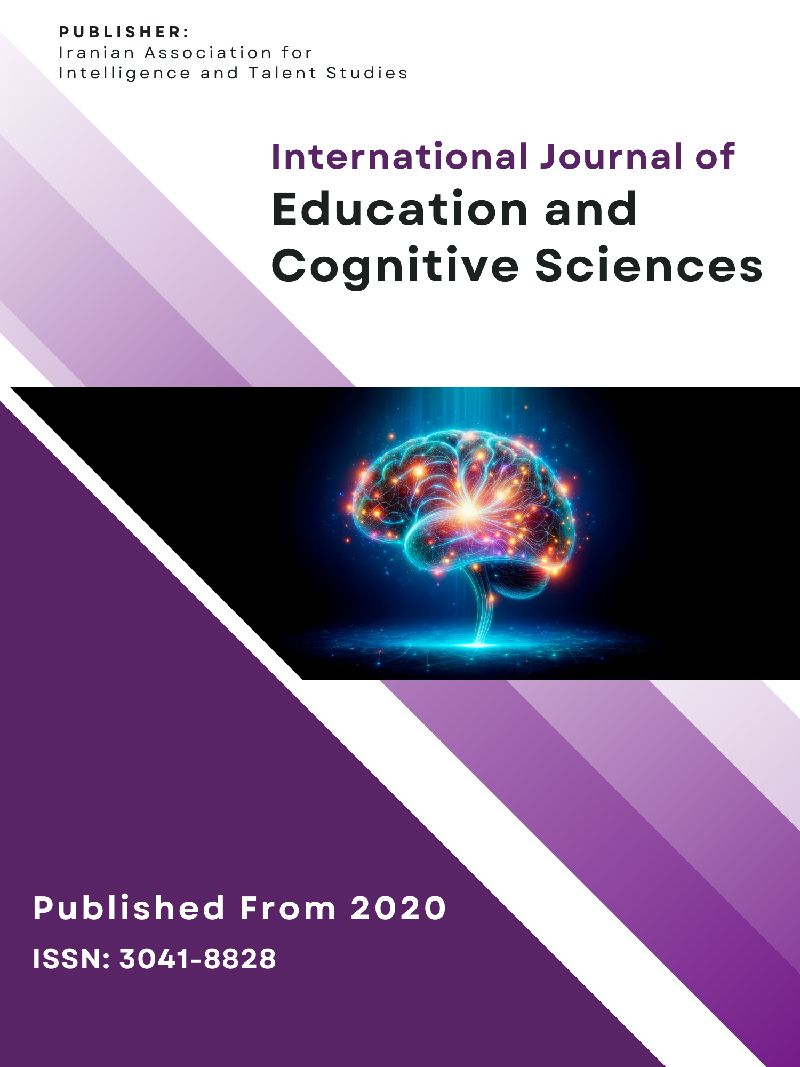The Effect of Relevant and Irrelevant Humor in Educational Content on the Academic Engagement of Fourth-Grade Male Students
Purpose: The objective of this study was to investigate the impact of relevant and irrelevant humor in the science curriculum on the academic engagement of fourth-grade elementary school students.
Methods and Materials: This study employed a quasi-experimental design with a multi-stage cluster sampling method. A total of 88 fourth-grade students from non-public schools in District 5 of Tehran participated in the study. Students were randomly assigned to three groups: the relevant humor intervention group, the irrelevant humor intervention group, and a control group. A humor-infused educational package combining relevant and irrelevant humor with science content was developed and implemented. Academic achievement was measured using a pre- and post-test design, and data were analyzed using analysis of covariance (ANCOVA).
Findings: The findings indicated a significant difference in academic achievement between the relevant humor group and the control group, with the relevant humor group showing greater improvement in academic performance (p < 0.05). There was no significant difference between the irrelevant humor group and the control group (p > 0.05). The eta squared value of 0.14 indicated that 14% of the variance in academic achievement was explained by the humor interventions.
Conclusion: The study concluded that incorporating relevant humor into the science curriculum can significantly enhance academic achievement by increasing student engagement, motivation, and understanding of the material. In contrast, irrelevant humor did not yield significant academic benefits, suggesting the importance of aligning humor with the curriculum content. Future research is needed to explore the long-term effects and broader impacts of humor interventions in education.
A Comparative Study of Perceived Parenting Styles, Anxiety Sensitivity, and Ego Strength in Female Victims of Domestic Violence Seeking Divorce, With and Without Generalized Anxiety Disorder
Purpose: This causal-comparative study compared perceived parenting styles (parental warmth and autonomy support), anxiety sensitivity, and ego strength among female victims of domestic violence seeking divorce, differentiating between those with and without generalized anxiety disorder (GAD).
Methods and Materials: The sample included 80 women (40 with GAD, 40 without GAD) from Qom Province, Iran, selected via convenience sampling in 2024-2025. Participants were screened using the Structured Clinical Interview for DSM-5 Disorders (SCID-5-RV) and completed the Grolnick Perceived Parenting Scale, the Taylor & Cox Anxiety Sensitivity Index, and the Markstrom Ego Strength Scale. Data were analyzed using Multivariate Analysis of Variance (MANOVA).
Findings: MANOVA revealed a significant overall difference between the two groups (Pillai’s Trace = .88, p <.001, η² = .88). The non-GAD group reported significantly higher levels of parental warmth (p <.001), parental autonomy support (p <.001), and ego strength (p <.001). Conversely, the GAD group exhibited significantly higher anxiety sensitivity (p <.001).
Conclusion: The findings indicate that a lack of parental warmth and autonomy during development, coupled with high anxiety sensitivity and low ego strength, is strongly associated with GAD in women experiencing the dual trauma of domestic violence and divorce. Interventions should focus on restructuring maladaptive cognitive schemas, enhancing emotion regulation, and building ego strength.
Design and Validation of a Spiritual Education Model Based on the Fundamental Transformation Document of Education
Purpose: The purpose of this study was to design and validate a comprehensive model of spiritual education derived from the Fundamental Reform Document of Education (FRDE) to identify its core dimensions, influencing factors, and structural validity within the Iranian educational context.
Methods and Materials: This applied qualitative study employed a content analysis approach. The research population included experts in education, school principals, and vice-principals. Using purposive non-random sampling and the principle of theoretical saturation, 20 experts were selected for semi-structured interviews. Data were gathered through both library (academic sources, theses, and databases from 2000 to 2022) and field methods. Thematic analysis was conducted using MAXQDA 2020 software, identifying basic, organizing, and overarching themes. The resulting model was further validated by 22 education specialists using a five-point Likert-scale questionnaire and evaluated through a one-sample t-test to determine its fit, comprehensibility, generalizability, and controllability.
Findings: The thematic analysis identified three main dimensions of spiritual education—cognitive, emotional, and behavioral training—along with four influencing factors: societal moral values and norms, educational policy and planning, teacher characteristics, and curriculum design. Results from the one-sample t-test showed that all model parameters were significant at the 0.01 level, confirming the model’s strong structural validity. The mean ratings for model fit (M=3.66), comprehensibility (M=3.89), generalizability (M=3.71), and control (M=3.85) were all significantly higher than the expected mean (3), indicating expert consensus on the reliability and applicability of the proposed model.
Conclusion: The validated model demonstrates that spiritual education, as defined by the FRDE, is a multidimensional construct integrating moral cognition, emotional development, and ethical behavior. Its successful implementation depends on teachers’ spiritual competence, value-based curricula, and supportive educational policies.
The Effectiveness of a Multi-Session Motivational Interviewing (MI-Supportive) Intervention Combined with Digital Follow-Up (EMA/SMS) in Reducing Marijuana Use and Enhancing Motivation to Change among Clinical Adolescents: A Randomized Controlled Trial
Purpose: This study presents a randomized controlled trial examining the effectiveness of a multi‑session Motivational Interviewing (MI‑Supportive) intervention augmented with ecological momentary assessment (EMA) and adaptive SMS follow‑up (MI + EMA/SMS) compared with an active supportive counseling control in reducing marijuana use and enhancing motivation to change among clinical adolescents.
Methods and Materials: Adolescents (N = 240; ages 13–18) referred from outpatient and inpatient adolescent clinical services were randomized 1:1 to receive either four manualized MI sessions (45–60 minutes each) with EMA/SMS digital follow‑up or an active, time‑matched supportive counseling control with non‑adaptive digital contact. Primary outcome was days of cannabis use in the past 30 days assessed via Timeline Followback at baseline, post‑intervention (8 weeks), 3‑month, and 6‑month follow‑up. Secondary outcomes included motivation to change (Readiness Ruler, URICA), cannabis‑related problems (CUDIT‑R), craving, and urine drug screen (UDS) results. EMA captured momentary motivation, craving, and contextual risk, and triggered adaptive SMS messages in the experimental arm. Analyses used intent‑to‑treat mixed‑effects models with multiple imputation for missing data.
Findings: Compared with the active control, the MI + EMA/SMS arm demonstrated greater reductions in days of cannabis use across follow‑up (adjusted mean difference at 6 months = −3.9 days, 95% CI −5.6 to −2.2; Cohen’s d ≈ 0.42, p < .001). Secondary outcomes favored the experimental arm, with larger increases in readiness to change, greater reductions in CUDIT‑R scores, lower proportion of UDS‑positive participants at 6 months (31% vs. 46%), and modest improvements in craving and depressive symptoms. Mediation analyses suggested that increases in EMA‑measured momentary motivation and reductions in craving partially mediated the intervention effect. EMA adherence averaged 72%.
Conclusion: In this trial, integrating multi‑session MI with EMA‑triggered supportive SMS yielded clinically meaningful reductions in adolescent cannabis use and increased motivation to change relative to an active control. These findings support the potential of hybrid, just‑in‑time interventions that combine high‑fidelity psychotherapy with adaptive digital support for adolescent substance use treatment. Future empirical trials are needed to replicate these results, evaluate long‑term durability, and assess cost‑effectiveness and equitable implementation.
The Causal Model of the Relationship Between Family Functioning and Perceived Social Support of Students with Internet Addiction: The Mediating Role of Stress Coping Strategies
Purpose: The present study aimed to propose a causal model of the relationship between family functioning and perceived social support of students with internet addiction, considering the mediating role of stress coping strategies.
Methods and Materials: The research design was fundamental in nature and employed a descriptive-correlational method based on structural equation modeling (SEM). The statistical population included all students of Islamic Azad University, North Tehran Branch, during the 2024–2025 academic year. From this population, a sample of 301 students was selected through multistage cluster sampling. Participants responded to the Young Internet Addiction Test (IAT), the Epstein Family Assessment Device (FAD), the Zimet Multidimensional Scale of Perceived Social Support (MSPSS), and the Endler and Parker Coping Inventory for Stressful Situations (CISS-SF). The collected data were analyzed using structural equation modeling with AMOS 26 software.
Findings: The results revealed that family functioning was negatively and significantly associated with internet addiction among students (p = .001). Perceived social support was also negatively and significantly associated with internet addiction (p = .001). Emotion-focused and avoidance coping styles were positively related to internet addiction, whereas the problem-focused coping style was negatively and significantly associated with it (p = .001). Moreover, both problem-focused and emotion-focused coping styles negatively and significantly mediated the relationship between family functioning and internet addiction (p = .001). All three coping styles negatively and significantly mediated the relationship between perceived social support and internet addiction (p = .001).
Conclusion: It can be concluded that positive family functioning and higher perceived social support are associated with lower levels of internet addiction. Emotion-focused and avoidance coping styles reinforce this association, whereas problem-focused coping weakens it.
Phenomenological Explanation of the Curriculum of Successful Startups in Iran
Purpose: The present study aimed to clarify a structural equation model of health anxiety based on metacognitive beliefs, with anxiety sensitivity serving as a mediator among individuals with obsessive–compulsive symptoms.
Methods and Materials: This descriptive–correlational research utilized structural equation modeling. The statistical population consisted of all individuals exhibiting obsessive–compulsive symptoms who attended counseling centers, psychological clinics, and psychiatric clinics in Isfahan during 2024–2025. A convenience sample of 480 participants was selected. The research instruments included the Short Health Anxiety Inventory (SHAI) developed by Salkovskis and Warwick, the Metacognitions Questionnaire-30 (MCQ-30) by Wells and Cartwright-Hatton, and the Anxiety Sensitivity Index (ASI) by Floyd et al. Data analysis was performed using SPSS and AMOS software, and structural equation modeling with bootstrapping was applied to test the hypotheses.
Findings: The findings revealed that all direct paths among the study variables were statistically significant at p < 0.05. Anxiety sensitivity significantly mediated the relationship between metacognitive beliefs and health anxiety. The bootstrap analysis indicated that the indirect effect of metacognitive beliefs on health anxiety was 0.141, which was significant at the 0.05 level.
Conclusion: The results demonstrated that dysfunctional metacognitive beliefs contribute to the development of health anxiety by heightening anxiety sensitivity. Consequently, modifying maladaptive metacognitive beliefs and implementing interventions aimed at reducing anxiety sensitivity—such as interoceptive exposure and symptom reappraisal—can play a vital role in managing and alleviating health anxiety among individuals with obsessive–compulsive symptoms.
The Relationship between Metacognitive Strategies with Academic Engagement According to the Mediating Role of Achievement Goals and Gender Moderation in Students
Purpose: The present study aimed to investigate the relationship between metacognitive strategies and academic engagement, considering the mediating role of achievement goals and gender moderation in students.
Methods and Materials: The descriptive research method was correlation type. The statistical population included all the students of Maysan University in Iraq in the 2023-2024 academic year, and 300 of them were selected by available sampling and responded to research tools including School Engagement Scale (Fredericks & Blumenfeld, 2004), the State Metacognition Invertory (O'Neill and Abedi, 1996), and Achievement Goals Questionnaire (Elliott and McGregor, 1988). Data were analyzed using Pearson's correlation coefficient and structural equation modeling and SPSS26 and PLS 3.2.8 software.
Findings: The results of the path analysis test showed that metacognitive strategies did not have a significant direct relationship with academic engagement. Still, indirectly and through the mediation of achievement goals, they had an effect on academic engagement, in such a way that Orientational progress goals led to an increase in academic engagement, and avoidance achievement goals led to a decrease in academic engagement. Also, gender played a moderating role in the relationship between metacognitive strategies and academic engagement.
Conclusion: According to the results of this study, teaching metacognitive strategies can increase students' academic engagement through a positive impact on their achievement goals.
Development and Validation of a Collaborative Continuing Professional Development (CCPD) Questionnaire for EFL Teachers: A Qualitative–Quantitative Study
Purpose: This study aimed to conceptualize, develop, and validate a reliable and context-specific questionnaire to measure Collaborative Continuing Professional Development (CCPD) among Iranian English as a Foreign Language (EFL) teachers.
Methods and Materials: A sequential mixed-methods design was employed. In the qualitative phase, thirty experienced EFL teachers from universities and language institutes participated in semi-structured interviews and focus group discussions. Data were analyzed using inductive thematic analysis to identify key dimensions of CCPD. These findings informed the development of an initial questionnaire. In the quantitative phase, the instrument was administered to 312 EFL teachers selected via purposive sampling and Cochran’s formula to ensure adequate sample size. Construct validity was examined through confirmatory factor analysis using Partial Least Squares (PLS), while internal consistency and reliability were assessed via Cronbach’s alpha, composite reliability (CR), and average variance extracted (AVE).
Findings: Seven core dimensions of CCPD emerged: active stakeholder participation, needs assessment and content localization, collaborative learning methods, policy and legal framework, evaluation and feedback system, motivational and structural support, and sustainability and future orientation. All constructs demonstrated strong psychometric properties, with Cronbach’s alpha values above 0.83 and CR exceeding 0.84. Outer loadings were higher than 0.80, and AVE surpassed the 0.58 threshold, confirming convergent validity. Structural modeling showed significant predictive relationships, particularly between policy and legal framework and sustainability (β = 0.42, p < .001) and between needs assessment and learning (β = 0.40, p < .001), explaining 58% of variance in sustainability and 40% in learning.
Conclusion: The validated CCPD questionnaire is a robust, contextually grounded tool for assessing collaborative professional development among Iranian EFL teachers.

About the Journal
To comply with standards and maintain uniformity of procedure based on the author's guide, please use the new format of the prepared template for articles. The authors' Commitment and Conflict form, after being completed and signed, should be uploaded in PDF or JPG format along with the article file on the submission system. If the above rules are not observed, the article will be unacceptable.
This publication follows the principles and standards of the Committee on Publication Ethics (COPE) in reviewing and publishing scientific articles.
We are delighted to announce that the International Journal of Education and Cognitive Sciences has been officially indexed on the prestigious EBSCO platform. This significant milestone underscores our commitment to academic excellence and enhances the global visibility and accessibility of our research.
For more details, please visit EBSCO.
International Journal of Education and Cognitive Sciences is a scientific open-access double-blind anonymous peer-review journal publishing original articles, reviews, short communications and scientific reports of a high scientific and ethical standard in Psychology-Educational. This journal is published four times per year, in English, by Iranian Association for Intelligence and Talent Studies. It covers scientific subjects in the following fields:
- Educational Theory and Practice
- Cognitive Sciences
- Technology in Education
- Assessment and Evaluation
- Sociocultural Factors in Education































